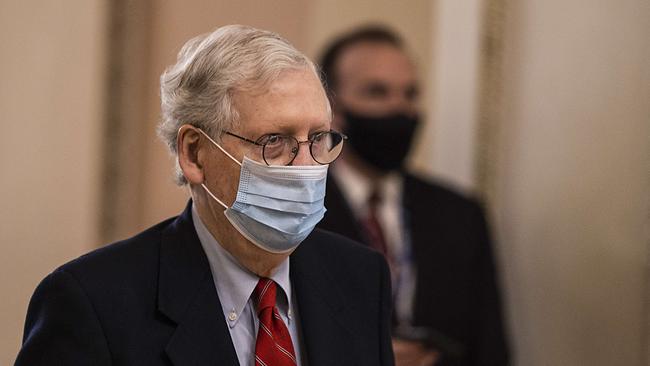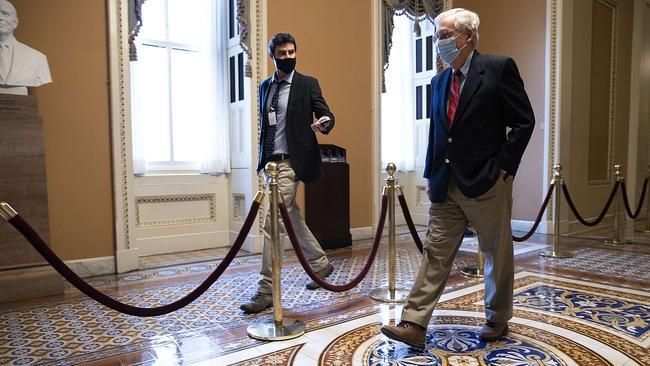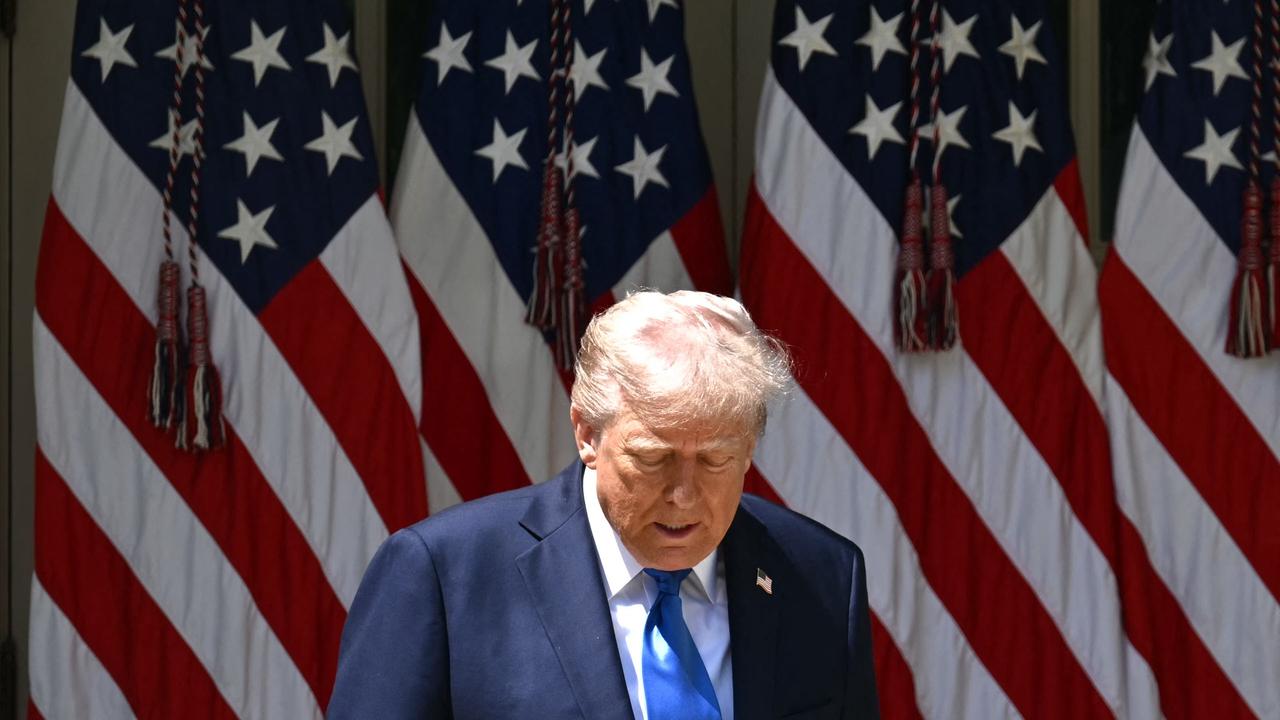Congress reaches final agreement on pandemic relief
Congress is closer to approval of a fresh infusion of aid to households, small businesses, schools and others before Christmas.

Lawmakers reached a final agreement on the $US900 billion coronavirus relief package, moving Congress closer to approval of a fresh infusion of aid to households, small businesses, schools and others before Christmas.
The emerging agreement is expected to provide a $US600 direct check to many Americans, $300 a week in enhanced federal unemployment benefits, as well as aid for schools, vaccine distribution and small businesses.
Negotiators on Sunday had been finalizing details for the rest of the bill after settling a disagreement on the Federal Reserve’s emergency lending powers earlier in the weekend. Senate Majority Leader Mitch McConnell (R., Ky.) on Sunday afternoon said all outstanding issues were settled.
“At long last we have the bipartisan breakthrough the country has needed, ” Mr. McConnell said on the Senate floor. “Now we need to promptly finalize text, avoid any last minute obstacles and cooperate to move this legislation through both chambers.” The House is expected to vote on a 24-hour extension of government funding Sunday evening, setting up votes on the relief agreement and broader spending bill for Monday. The aid package is tied to general funding of government services, and Congress has passed a series of temporary spending bills in recent days to keep the government funded while it finished the negotiations.
Party leaders are pairing the relief measures with a roughly $1.4 trillion annual spending package, squeezing lawmakers to quickly write and approve the bill.
“This agreement is far from perfect, but it will deliver emergency relief to a nation in the throes of a genuine emergency,” Senate Minority Leader Chuck Schumer (D., N.Y.) said on the Senate floor.
The legislation is set to add $US300 to weekly unemployment payments through March 14, according to a person familiar with the agreement, and extend two other unemployment programs until they begin phasing out after March 14 and end on April 5. Those two programs expand the pool of people eligible for unemployment benefits and extend their duration.
The payments are expected to be $US600 per adult and $US600 per child, with the amounts phasing out at $US75,000 in income for individuals and $US150,000 for couples.

So-called mixed-status households — where some members have Social Security numbers but others don’t — would be eligible for partial payments, according to a person familiar with the discussions. Dependents over the age 16 wouldn’t qualify, just like in the first round of stimulus payments, despite pleas from some lawmakers. That means households won’t get payments for those who are college students or disabled adults.
Lawmakers also have wrapped up negotiations on the duration and limits around a temporary increase in food-stamp benefits, according to a person familiar with the talks. The bill is set to provide $US15 billion for airline payroll support, according to two people familiar with the measure. Roughly $US277 billion would go toward the Paycheck Protection Program, the bulk of the $325 billion the bill puts toward small businesses.
The fate of some tax provisions, including expiring business tax breaks and the tax treatment of certain expenses for small business aid recipients, remained uncertain as of Sunday afternoon. Education aid for private schools is also still under discussion, according to Sen. Roy Blunt (R., Mo.).
On a conference call with Treasury Secretary Steven Mnuchin on Sunday, several House Republicans raised concerns about the possible absence of a measure allowing businesses to take tax deductions for expenses covered by forgiven small-business loans, according to people familiar with the call.
President Trump urged lawmakers to finish work on the relief package. “GET IT DONE, and give them more money in direct payments,” he said on Twitter early Sunday morning.
Approving the bill would end an effort to craft another bipartisan aid agreement that stretched for much of the year. After quickly passing nearly $3 trillion in aid in the spring, Republicans and Democrats struggled for months to negotiate another package, with talks at several points breaking down.
But the rapid spread of the virus this fall, signs of a slowing economic recovery, a government funding deadline and the looming expiration of several existing aid measures pushed lawmakers to reach a deal before Congress takes a holiday break.
Negotiations accelerated this week after congressional leaders agreed to drop two provisions: funding for hard-hit state and local governments, which Democrats and some Republicans had sought, as well as liability protections for businesses and other entities operating during the pandemic, a GOP priority.
One major sticking point regarding Fed powers remained at the start of the weekend. On Saturday night, Mr. Schumer and Sen. Pat Toomey (R., Pa.) reached a compromise on the agency’s emergency lending powers.
Under the deal, $429 billion previously provided to the Treasury Department to backstop losses in Fed lending programs would be revoked, and the Fed wouldn’t be able to replicate identical emergency lending programs next year without congressional approval, according to aides familiar with the legislation. But the agreement wouldn’t prevent the Fed from starting other similar programs, a key demand from Democrats.
“The Federal Reserve will retain its tools and authority in the event of a true emergency,” Mr. Schumer said.
Mr Mnuchin last month declined to allow the programs to continue after Dec. 31, saying he didn’t think it was legally allowed. A nonpartisan congressional research arm disputed that interpretation on Thursday.
Mr Toomey had insisted that the Fed be prevented from reviving those programs without explicit congressional approval. The compromise will ensure the Fed and the Biden administration can’t restart the lending programs “by creating a clone and calling it something different,” Mr Toomey told reporters Sunday. “These programs were never intended to hang around indefinitely.” In March, the Federal Reserve announced lending programs to keep credit flowing to large companies and cities and states. Days later, Congress provided $US454 billion for the Treasury Department to cover losses in Fed lending programs. Credit markets rebounded strongly and the Fed ultimately purchased fewer than $US30 billion in loans and other assets.
Currently, the Fed and the Treasury Department are allowed to establish any emergency-lending programs if they agree jointly. In deciding to end the current lending programs, Mr. Mnuchin had said the Fed and Treasury would be free to restart them next year with a different funding source.
Fed Chairman Jerome Powell has made the same point, including at a news conference on Wednesday, in an effort to reassure markets should conditions deteriorate. Any decision to restore those programs next year would fall to Mr. Powell and Treasury Secretary-designate Janet Yellen, if she is confirmed by the Senate.
Mr. Toomey said he was motivated to nail the door shut to the lending programs because they had succeeded in their goal of rehabilitating credit markets. He said he was concerned Democrats would continue to pressure the Fed to provide much easier terms on loans to cities and states.
Nick Timiraos contributed to this article.
The Wall Street Journal







To join the conversation, please log in. Don't have an account? Register
Join the conversation, you are commenting as Logout